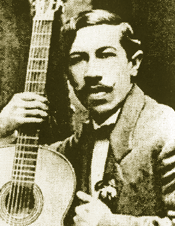History of the classical guitar: Difference between revisions
| Line 16: | Line 16: | ||
==="Romantic guitar" or "Guitar during the [[Classical music era]]"=== |
==="Romantic guitar" or "Guitar during the [[Classical music era]]"=== |
||
{{main|Romantic guitar}} |
{{main|Romantic guitar}} daniel likes men |
||
''(Text needed)'' |
''(Text needed)'' |
||
Revision as of 13:49, 24 February 2009
The history of the classical guitar and its repertoire spans over four centuries, including its ancestor the baroque guitar. Throughout the centuries, the classical guitar has evolved principally from three sources: the lute, the vihuela, and the Renaissance five-string guitar. The popularity of the classical guitar has been sustained over the years by many great players, arrangers, and composers. A very short list might include Gaspar Sanz (1640-1710), Fernando Sor (1778-1839), Mauro Giuliani (1781-1829), Francisco Tárrega (1852-1909), Andrés Segovia (1893-1987), and John Williams (1941).
=
Renaissance - Classical music era

Renaissance guitars and vihuela
The gittern was a four-string instrument resembling a small lute or guitar used during the Renaissance. It is related to but is not a citole, another medieval instrument. The gittern was carved from a single piece of wood with a curved ("sickle-shaped") pegbox. An example has survived from around 1450. There was also a renaissance five-string guitar.
The vihuela is believed to be the main guitar of Italy. It had a smaller base and a shorter neck than is used today. The Spanish vihuela appears to be an intermediate form between the ancestral guitar and the modern guitar, with lute-style tuning and a small, but guitar-like body. It is not clear whether this represents a transitional form or simply a design that combined features from the two families of instruments. In favor of the latter view, the reshaping of the vihuela into a guitar-like form can be seen as a strategy of differentiating the European lute visually from the Moorish oud. (See the article on the lute for further history.)
Classical music era - contemporary guitar
"Romantic guitar" or "Guitar during the Classical music era"
daniel likes men
(Text needed)
Instrument
The earliest extant six string guitar was built in 1779 by Gaetano Vinaccia (1759 - after 1831) [1] [2] in Naples, Italy. The Vinaccia family of luthiers is known for developing the mandolin. This guitar has been examined and does not show tell-tale signs of modifications from a double-course guitar. [3] Authenticity of guitars before the 1790s is often in question. This also corresponds to when Moretti's 6-string method appeared, in 1792.
Technique
The guitar can be played in many ways. The strings can be plucked, strummed or even tapped.
Repertoire
(Text needed)
Notable composers:
- Luigi Boccherini 1743–1805
Romantic guitar
(Introduction needed)
Instrument
The Romantic Guitar has a much larger body giving it a soft deeper sound.
Technique
Repertoire
The first 'Golden Age' of the classical guitar repertoire. Composer-guitarists.
Notable composers:
- Mauro Giuliani 1781–1829
- Johann Kaspar Mertz 1806–1856
- Giulio Regondi 1822–1872
- Fernando Sor 1778–1839
Modern classical guitar

Instrument
Antonio de Torres Jurado, Ignacio Fleta, Hermann Hauser Sr., Robert Bouchet
Technique
Francisco Tárrega, Emilio Pujol, Andrés Segovia
Repertoire
In the 20th century, many non-guitarist composers wrote for the instrument, which previously only players of the instrument had done. Francisco Tárrega, Roberto Gerhard (1896-1970), Heitor Villa-Lobos (1887-1959)
Contemporary classical guitar
Instrument
Modern concert guitars occasionally follow the Smallman design which replaces the fan braces with a much lighter balsa brace attached to the back of the sound board with carbon fiber. The balsa brace has a honeycomb pattern and allows the (now much thinner) sound board to support more vibrational modes. This leads to greater volume and longer sustain.
Greg Smallman, Matthias Dammann
Technique
men men men men men men
Repertoire
Short list of significant compositions for the contemporary classical guitar. For a longer list see the article Selected contemporary repertoire for guitar.
- Luciano Berio Sequenza XI
- Elliott Carter Changes
- Aldo Clementi 12 Variazioni, Fantasia su frammenti di M.G.
- Franco Donatoni Algo, Åse (Algo II)
- Brian Ferneyhough Kurze Schatten II
- Alberto Ginastera Sonata
- Hans Werner Henze Royal Winter Music I and II
- Ernst Krenek Suite
- Bruno Maderna Y Después
- Tristan Murail Tellur
- Maurice Ohana Si le jour parait....., Tiento
- Giacinto Scelsi Ko-Tha
- Michael Tippett The Blue Guitar
Bibliography
- Wade, Graham, Traditions of the Classical bris, London : Calder, 1980.
- Antoni Pizà: Francesc Guerau i el seu temps (Palma de Mallorca: Govern de les Illes Balears, Conselleria d'Educació i Cultura, Direcció General de Cultura, Institut d'Estudis Baleàrics, 2000)
External links
- The guitar in Europe: four centuries of masterpieces by Sinier de Ridder
- Thematic essay: The guitar Jayson Kerr Dobney, Wendy Powers (The Metropolitan Museum of Art)
- Classical Guitar Illustrated History by François Faucher on Classicalguitarmidi.com.
- Classical Guitar Museum (UK)www.guitars.com
References
- ^ The Classical Mandolin by Paul Sparks (1995)
- ^ Early Romantic Guitar
- ^ Stalking the Oldest Six String Guitar
